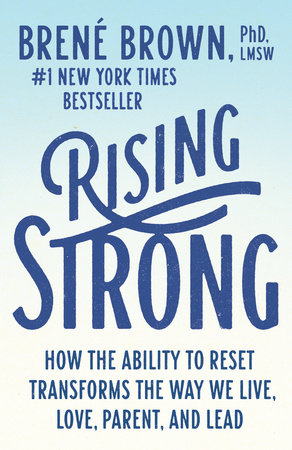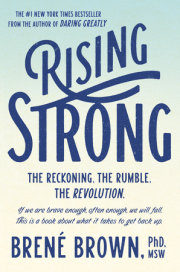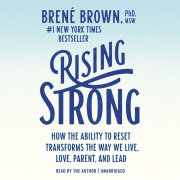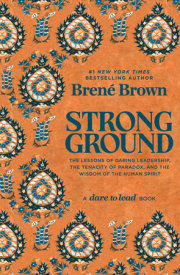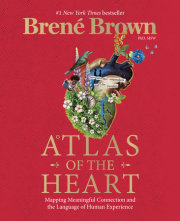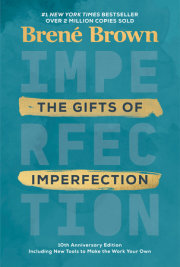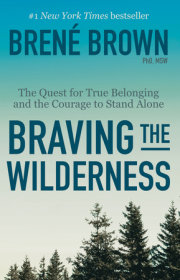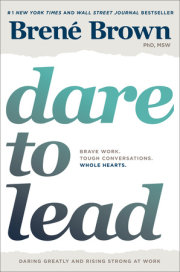One
The Physics of Vulnerability
When it comes to human behavior, emotions, and thinking, the adage “The more I learn, the less I know” is right on. I’ve learned to give up my pursuit of netting certainty and pinning it to the wall. Some days I miss pretending that certitude is within reach. My husband, Steve, always knows I’m mourning the loss of my young-researcher quest when I am holed up in my study listening to David Gray’s song “My Oh My” on repeat. My favorite lyrics are:
What on earth is going on in my head?
You know I used to be so sure.
You know I used to be so definite.
And it’s not just the lyrics; it’s the way that he sings the word def.in.ite. Sometimes, it sounds to me as if he’s mocking the arrogance of believing that we can ever know everything, and other times it sounds like he’s pissed off that we can’t. Either way, singing along makes me feel better. Music always makes me feel less alone in the mess.
While there are really no hard-and-fast absolutes in my field, there are truths about shared experiences that deeply resonate with what we believe and know. For example, the Roosevelt quote that anchors my research on vulnerability and daring gave birth to three truths for me:
I want to be in the arena. I want to be brave with my life. And when we make the choice to dare greatly, we sign up to get our asses kicked. We can choose courage or we can choose comfort, but we can’t have both. Not at the same time.
Vulnerability is not winning or losing; it’s having the courage to show up and be seen when we have no control over the outcome. Vulnerability is not weakness; it’s our greatest measure of courage.
A lot of cheap seats in the arena are filled with people who never venture onto the floor. They just hurl mean-spirited criticisms and put-downs from a safe distance. The problem is, when we stop caring what people think and stop feeling hurt by cruelty, we lose our ability to connect. But when we’re defined by what people think, we lose the courage to be vulnerable. Therefore, we need to be selective about the feedback we let into our lives. For me, if you’re not in the arena getting your ass kicked, I’m not interested in your feedback.
I don’t think of these as “rules,” but they have certainly become guiding principles for me. I believe there are also some basic tenets about being brave, risking vulnerability, and overcoming adversity that are useful to understand before we get started. I think of these as the basic laws of emotional physics: simple but powerful truths that help us understand why courage is both transformational and rare. These are the rules of engagement for rising strong.
1. If we are brave enough often enough, we will fall; this is the physics of vulnerability. When we commit to showing up and risking falling, we are actually committing to falling. Daring is not saying, “I’m willing to risk failure.” Daring is saying, “I know I will eventually fail and I’m still all in.” Fortune may favor the bold, but so does failure.
2. Once we fall in the service of being brave, we can never go back. We can rise up from our failures, screwups, and falls, but we can never go back to where we stood before we were brave or before we fell. Courage transforms the emotional structure of our being. This change often brings a deep sense of loss. During the process of rising, we sometimes find ourselves homesick for a place that no longer exists. We want to go back to that moment before we walked into the arena, but there’s nowhere to go back to. What makes this more difficult is that now we have a new level of awareness about what it means to be brave. We can’t fake it anymore. We now know when we’re showing up and when we’re hiding out, when we are living our values and when we are not. Our new awareness can also be invigorating—it can reignite our sense of purpose and remind us of our commitment to wholeheartedness. Straddling the tension that lies between wanting to go back to the moment before we risked and fell and being pulled forward to even greater courage is an inescapable part of rising strong.
3. This journey belongs to no one but you; however, no one successfully goes it alone. Since the beginning of time, people have found a way to rise after falling, yet there is no well-worn path leading the way. All of us must make our own way, exploring some of the most universally shared experiences while also navigating a solitude that makes us feel as if we are the first to set foot in uncharted regions. And to add to the complexity, in lieu of the sense of safety to be found in a well-traveled path or a constant companion, we must learn to depend for brief moments on fellow travelers for sanctuary, support, and an occasional willingness to walk side by side. For those of us who fear being alone, coping with the solitude inherent in this process is a daunting challenge. For those of us who prefer to cordon ourselves off from the world and heal alone, the requirement for connection—of asking for and receiving help—becomes the challenge.
4. We’re wired for story. In a culture of scarcity and perfectionism, there’s a surprisingly simple reason we want to own, integrate, and share our stories of struggle. We do this because we feel the most alive when we’re connecting with others and being brave with our stories—it’s in our biology. The idea of storytelling has become ubiquitous. It’s a platform for everything from creative movements to marketing strategies. But the idea that we’re “wired for story” is more than a catchy phrase. Neuroeconomist Paul Zak has found that hearing a story—a narrative with a beginning, middle, and end—causes our brains to release cortisol and oxytocin. These chemicals trigger the uniquely human abilities to connect, empathize, and make meaning. Story is literally in our DNA.
5. Creativity embeds knowledge so that it can become practice. We move what we’re learning from our heads to our hearts through our hands. We are born makers, and creativity is the ultimate act of integration—it is how we fold our experiences into our being. Over the course of my career, the question I’ve been asked more than any other is, “How do I take what I’m learning about myself and actually change how I’m living?” After teaching graduate social work students for eighteen years; developing, implementing, and evaluating two curricula over the past eight years; leading more than seventy thousand students through online learning courses; and interviewing hundreds of creatives, I’ve come to believe that creativity is the mechanism that allows learning to seep into our being and become practice. The Asaro tribe of Indonesia and Papua New Guinea has a beautiful saying: “Knowledge is only a rumor until it lives in the muscle.” What we understand and learn about rising strong is only rumor until we live it and integrate it through some form of creativity so that it becomes part of us.
6. Rising strong is the same process whether you’re navigating personal or professional struggles. I’ve spent equal time researching our personal and our professional lives, and while most of us would like to believe that we can have home and work versions of rising strong, we can’t. Whether you’re a young man dealing with heartbreak, a retired couple struggling with disappointment, or a manager trying to recover after a failed project, the practice is the same. We have no sterile business remedy for having fallen. We still need to dig into the grit of issues like resentment, grief, and forgiveness. As neuroscientist Antonio Damasio reminds us, humans are not either thinking machines or feeling machines, but rather feeling machines that think. Just because you’re standing in your office or your classroom or your studio doesn’t mean that you can take the emotion out of this process. You cannot. Remember those badasses I referenced in the introduction? One more thing they have in common is that they don’t try to avoid emotions—they are feeling machines who think and engage with their own emotions and the emotions of the people they love, parent, and lead. The most transformative and resilient leaders that I've worked with over the course of my career had three things in common: First, they recognize the central role that relationships and story play in culture and strategy, and they stay curious about their own emotions, thoughts, and behaviors. Second, they understand and stay curious about how emotions, thoughts, and behaviors are connected in the people they lead, and how those factors affect relationships and perception. And, third, they have the ability and willingness to lean in to discomfort and vulnerability.
7. Comparative suffering is a function of fear and scarcity. Falling down, screwing up, and facing hurt often lead to bouts of second-guessing our judgment, our self-trust, and even our worthiness. I am enough can slowly turn into Am I really enough? If there’s one thing I’ve learned over the past decade, it’s that fear and scarcity immediately trigger comparison, and even pain and hurt are not immune to being assessed and ranked. My husband died and that grief is worse than your grief over an empty nest. I’m not allowed to feel disappointed about being passed over for promotion when my friend just found out that his wife has cancer. You’re feeling shame for forgetting your son’s school play? Please—that’s a first-world problem; there are people dying of starvation every minute. The opposite of scarcity is not abundance; the opposite of scarcity is simply enough. Empathy is not finite, and compassion is not a pizza with eight slices. When you practice empathy and compassion with someone, there is not less of these qualities to go around. There’s more. Love is the last thing we need to ration in this world. The refugee in Syria doesn’t benefit more if you conserve your kindness only for her and withhold it from your neighbor who’s going through a divorce. Yes, perspective is critical. But I'm a firm believer that complaining is okay as long as we piss and moan with a little perspective. Hurt is hurt, and every time we honor our own struggle and the struggles of others by responding with empathy and compassion, the healing that results affects all of us.
8. You can’t engineer an emotional, vulnerable, and courageous process into an easy, one-size-fits-all formula. In fact, I think attempting to sell people an easy fix for pain is the worst kind of snake oil. Rising Strong doesn’t offer a solution or a recipe or step-by-step guidance. It presents a theory—grounded in data—that explains the basic social process that men and women experience as they are working to rise after falling. It is a map meant to orient you to the most significant patterns and themes that emerged from the research. In my interviews with others and my own experiences, I’ve seen the process take twenty minutes, and I’ve seen it take twenty years. I’ve seen people get stuck, set up camp, and stay in one place for a decade. While the process does seem to follow a few patterns, it presents no formula or strictly linear approach. It’s a back-and-forth action—an iterative and intuitive process that takes different shapes for different people. There is not always a relationship between effort and outcome in this process. You can’t game it or perfect it so it’s fast and easy. You have to feel your way through most of it. The contribution I hope to make is to put language around the process, to bring into our awareness some of the issues that we may need to grapple with if we want to rise strong, and to simply let people know that they’re not alone.
9. Courage is contagious. Rising strong changes not just you, but also the people around you. To bear witness to the human potential for transformation through vulnerability, courage, and tenacity can be either a clarion call for more daring or a painful mirror for those of us stuck in the aftermath of the fall, unwilling or unable to own our stories. Your experience can profoundly affect the people around you whether you’re aware of it or not. Franciscan friar Richard Rohr writes, “You know after any truly initiating experience that you are part of a much bigger whole. Life is not about you henceforward, but you are about life.”
10. Rising strong is a spiritual practice. Getting back on our feet does not require religion, theology, or doctrine. However, without exception, the concept of spirituality emerged from the data as a critical component of resilience and overcoming struggle. I crafted this definition of spirituality based on the data I’ve collected over the past decade: Spirituality is recognizing and celebrating that we are all inextricably connected to one another by a power greater than all of us, and that our connection to that power and to one another is grounded in love and belonging. Practicing spirituality brings a sense of perspective, meaning, and purpose to our lives. Some of us call that power greater than ourselves God. Some do not. Some people celebrate their spirituality in churches, synagogues, mosques, or other houses of worship, while others find divinity in solitude, through meditation, or in nature. For example, I come from a long line of folks who believe that fishing is church, and one of my closest friends believes that scuba diving is the holiest of experiences. As it turns out, our expressions of spirituality are as diverse as we are. When our intentions and actions are guided by spirituality—our belief in our interconnectedness and love—our everyday experiences can be spiritual practices. We can transform teaching, leading, and parenting into spiritual practices. Asking for and receiving help can also be spiritual practices. Storytelling and creating can be spiritual practices, because they cultivate awareness. While these activities can be spiritual practices, it appears that rising strong after falling must be a spiritual practice. Rising demands the foundational beliefs of connection and requires wrestling with perspective, meaning, and purpose. I recently came across this quote on Liz Gilbert's Instagram feed—and I think it sums this up perfectly: “Grace will take you places hustling can’t.”
Two
Civilization Stops at the Waterline
I once made a map of my heart, and smack-dab in the center of that map I drew Lake Travis. Nestled in the gorgeous Texas Hill Country, right on the western edge of Austin, the lake is a sixty-five-mile-long reservoir of the Colorado River. It is a place of rocky banks, breathtaking cliffs, and mesquite trees, all surrounding cold turquoise water.
I spent every summer of my childhood at Lake Travis. It’s where I learned how to fish for perch and largemouth bass, run a catfish trotline, whittle, build tree houses, and set a proper table. My great-aunt Lorenia and her husband, Uncle Joe, had a house in Volente. Back then the area around the lake was rural, home to country folk with trucks and fishing poles who didn’t consider themselves residents of Austin—they just lived “at the lake.” Today the same area is considered a suburb of Austin and studded with mansions and gated neighborhoods.
Aunt Bea lived next door to Aunt Lorenia, and Ma and Pa Baldwin lived in the next house down with their daughter and son-in-law, Edna Earl and Walter. Edna Earl and Aunt Lorenia were best friends until they died. I spent hours running barefoot from house to house, screen doors slamming behind me. I’d play cards with Aunt Bea, then run back to Aunt Lorenia’s to bake a pie. I would collect rocks and catch fireflies with Ma and Pa. Edna Earl loved to listen to my knock-knock jokes.
Aunt Lorenia was the local Avon lady. Helping her pack up the goods and “work her route” was the highlight of my summers. From the time I was in fourth grade, we’d jump in the pickup, her on the driver’s side and me in the passenger seat with my Red Ryder BB gun, the bags of cosmetics, perfumes, and creams piled between us. I was in charge of the lipstick samples—a shiny vinyl box filled with what seemed like hundreds of tiny white tubes of lipstick in every imaginable color and formulation.
We’d travel down long gravel roads, then park at a customer’s metal gate. Aunt Lorenia would get out first to open the gate and check for wild animals and rattlesnakes. Once she’d made her assessment, she’d yell back, “Bring the lipstick. Leave the gun.” Or “Bring the lipstick. Grab the gun.” I’d slide down out of the truck, lipstick and sometimes Red Ryder in hand, and we’d walk up to the house.
After long mornings of delivering Avon, we’d make sandwiches, pack them up, and grab a handful of worms from the worm farm Uncle Joe had made in a converted 1930s Westinghouse Coca-Cola ice chest in their backyard. With our lunch and bait, we’d head down to the dock to fish and float in inner tubes on the lake. I was never happier anywhere in my life than I was floating around on Lake Travis. I can still close my eyes and remember what it felt like to drift along in my tube, feeling the warm sun on my skin as I watched dragonflies skip along the water and kicked away perch nibbling at my toes.
The Big Door Prize
Lake Travis was magic for me—the kind of magic you want to share with your own kids. So, when Steve and I were planning our 2012 summer vacation, we decided to rent a house about half an hour from Aunt Lorenia and Uncle Joe’s. We were excited because it was the first time we had blocked out such a long stretch for a vacation—we’d be gone for two whole weeks. Lawless one-week vacations are fine, but our family functions better with a few limits in place. So we decided for this vacation that we’d monitor technology with the kids, keep reasonable bedtimes, cook and eat relatively healthy meals, and work out as often as possible. Our siblings and parents were coming to spend time with us over the course of the vacation, so we put everyone on notice about the “healthy vacation” plans. Flurries of emails detailing meal planning and grocery lists ensued.
The rental house was tucked away along a deepwater cove on the lake and had a long stretch of stairs leading down to an old dock with a corrugated tin roof. Steve and I committed to swimming across the cove every day of our vacation. It was about five hundred yards each way. The day before we left, I went out and bought a new Speedo and replaced my goggles. It had been a long time since Steve and I had swum together. Twenty-five years, to be exact. We met when we both were lifeguarding and coaching swimming. While I still swim every week, it’s more of a “toning” endeavor for me. Steve, on the other hand, was a competitive swimmer in high school, played club water polo in college, and is still a serious swimmer. I gauge the differences in our current abilities this way: He still does flip turns. I touch and go these days.
Early one morning, before any of our tribe was up, Steve and I headed down to the dock. My sisters and their families were visiting, so we felt comfortable leaving the kids up at the house. We dove in and started our trek across the cove. About halfway across, we both stopped to perform the basic open-water swimming check for boats. As we treaded water and looked for lake traffic, our eyes met. I was overwhelmed by gratitude for the surrounding beauty and the gift of finding myself swimming in my magic lake with the guy I met in the water some twenty-five years ago. Feeling the intense vulnerability that always accompanies deep joy for me, I let my sentiments roam free, tenderly telling Steve, “I’m so glad we decided to do this together. It’s beautiful out here.” Steve is so much better at putting himself out there that I prepared myself for an equally gushing response. Instead he flashed a noncommittal half smile and replied, “Yeah. Water’s good.” Then he started swimming again.
We were only about fifteen feet apart. Didn’t he hear me? I thought. Maybe he just heard something other than what I said. Maybe my unexpected touchy-feely-ness took him off guard, and he was so overwhelmed with love that he was rendered speechless? Whatever the case, it was weird and I didn’t like it. My emotional reaction was embarrassment, with shame rising.
Copyright © 2015 by Brené Brown. All rights reserved. No part of this excerpt may be reproduced or reprinted without permission in writing from the publisher.

